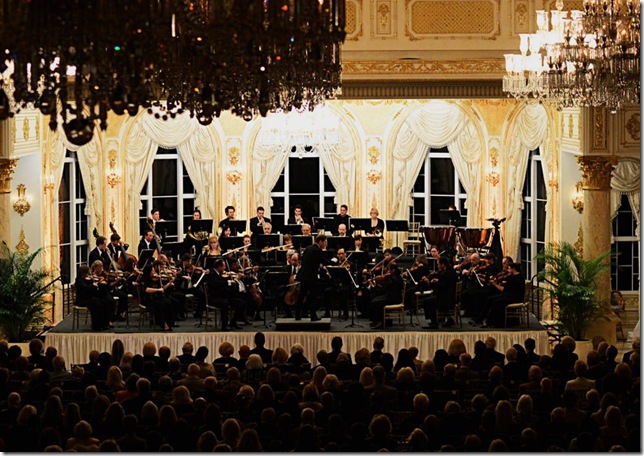In olden days, the Elector of Cologne nurtured the young Beethoven and gave him the opportunity to play in his Bonn Court Orchestra. The nobility, back then, knew that cultivation of the arts made for a happy populace: Music-making reflected well on them.
Jump to the 21st century and we find another kind of nobleman, billionaire Donald Trump, baron of all he surveys, placing his magnificent marriage palace at the disposal of the Palm Beach Symphony. With titles outlawed in the United States, successful American businessmen find that support of the arts is the next best thing to a knighthood.
About 600 of the great and the good of Palm Beach gathered at Mar-a-Lago on Friday, feted with glasses of wine or champagne as they progressed into the mansion’s main hall. A veritable combination of Versailles elegance and Elm Court, decorated with lavish gilt-on-white, its 16 sparkling crystal chandeliers suspended from a solid Scots baronial ceiling.
And bingo, at last, a perfect acoustic for this orchestra. The spaciousness of the hall allowed for wide rows. Each single gilt-cushioned chair had its own space. A light tan carpet covered the floor. And the semi-circular apse at the top end nicely housed the 45-piece symphony (the apse ceiling looked like a tastefully decorated wedding cake).
One would think the music might take a back seat amid all this splendor. Not at all. It enhanced the richness of the occasion.
Written in 1808, the Pastorale Symphony (No. 6 in F, Op. 68) is really a description of Beethoven’s love of the countryside. He made the distinction that it was about how he felt, rather than how the fields and streams looked.
The music’s soft opening bars have a pastoral country feeling; one is immediately caught up in Beethoven’s reverie. French horns suggest a distant hunt, and woodwinds echo this. The beautifully played strings accompany a lone clarinet and flute at the end of this movement as if distant friends are calling from across the valley.
Babbling brooks, winding rivers and lots of birdsong come to mind in the second movement, marked Andante molto mosso. Beethoven imitates the call of the nightingale and the cuckoo in a precursor to the program music that would become so popular at the other end of the century.
The third, Allegro, has rollicking dance music punctuated by thrilling solos of French horns. Two phases end with lovely trumpet blasts holding a long sonorous A that finally tails off. All around the hall, people were beating time to the music with tapping feet, including the illustrious Donald Trump. The orchestra, playing full out here, sounded terrific in this venue.
An orchestral thunderstorm and heavy raindrops end the dances. The last movement, Allegretto, was brash at times, the brass section overpowering the exemplary string section, which with two or three additional first violins and another double bass would have given balance to the brass.
Beethoven’s Fifth Symphony, with its familiar four-note opening motif (likened to the Morse code equivalent for V-for-victory during World War II) ended the program. The second movement has sweeping cellos that lead to a massive crescendo as the music swells to a march-like statement.
In the third movement we’re back to the victory signal on the horns. The orchestra sounded great, especially in the fugal section: these players enjoyed showing off their fine musicianship. Taken very fast, the Allegro was stirring. Conductor Ramon Tebar had them playing like demons with enormous amounts of energy. We felt Beethoven’s dynamic and brilliant syncopation taking over as the fourth movement ends with an unmistakable musical full stop.
Roars of approval from the elegant crowd greeted the performance, and rightly so: the musicians gave it their all. Tebar looked delighted at such an enthusiastic reception from the audience. What a difference this new hall made. Upon reflection, it occurred to me that Donald Trump may well be setting an example to the young billionaire computer entrepreneurs to get well and truly involved in the arts.
